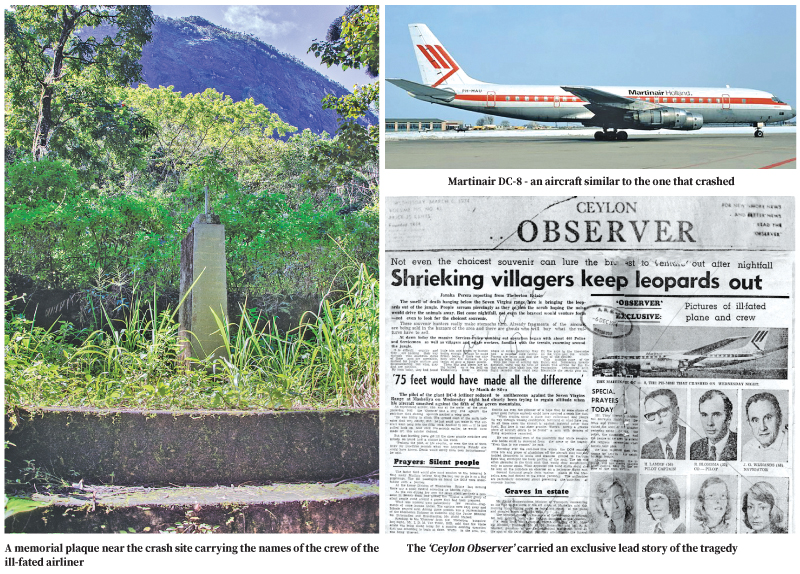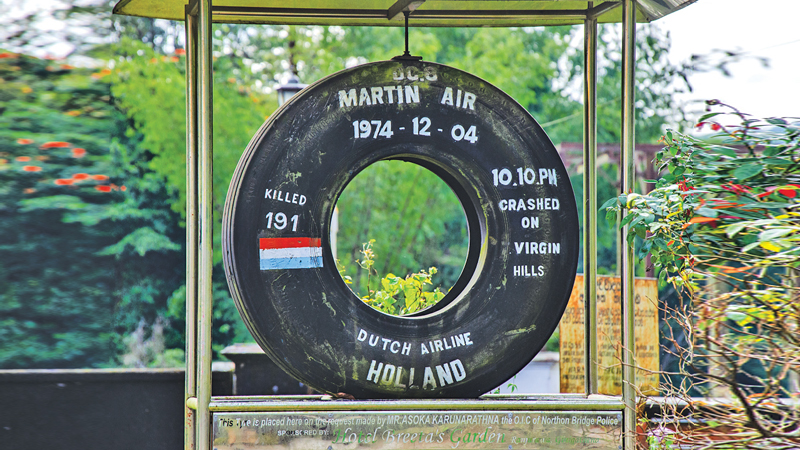 Having written about ‘The Bridge on the River Kwai’ film last week which was shot in the environs of the Kelani Ganga in Kitulgala, I remembered the tragic air crash at the Seven Virgin Hills off Norton Bridge further up, in the Maskeli Oya valley which is the main tributary of the Kelani Ganga.
Having written about ‘The Bridge on the River Kwai’ film last week which was shot in the environs of the Kelani Ganga in Kitulgala, I remembered the tragic air crash at the Seven Virgin Hills off Norton Bridge further up, in the Maskeli Oya valley which is the main tributary of the Kelani Ganga.
Our attention was drawn to the tragic crash and we intend to delve into the reasons for the crash. We made a trek to Norton Bridge via Ginigathhena further up on the Maskeliya Road. The isolated village of Koththalena lies below the crash site of the Seven Virgin Hills which is a ridge over 4,640 ft high. I was able to see some of the remnants of the crash and also met an eyewitness to the tragedy that occurred in 1974.
Re-living the tragedy
Reaching the village of Koththalena at the Theberton Tea Estate in the foothills of the Seven Virgin Hills which is the closest village to the air crash, I met K.A. Ariyapala, 66, now, a grocery owner, who was then a 16-year-old youth in the village. He re-lived the tragic event with us, sitting cozily in his tea boutique in the foothills of the scenic mountain ridge.
It was December 1974 and Hajj was in full swing. The Hajj pilgrimage is known as the greatest pilgrimage in the world, with millions of devout Muslims travelling to Mecca every year. It is a requirement for every wealthy Muslim to accomplish the Hajj at least once in their lifetime.
This has been a lucrative business for airlines, with chartered aircraft from all over the world helping pilgrims to make the long journey. Martinair (a charter subsidiary of KLM Royal Dutch Airlines) was operating this flight on behalf of Garuda, Indonesia’s national carrier.
The timing of the Hajj is based on the Islamic lunar calendar, so it varies from year to year on the Gregorian calendar, which is used by much of the world. In 1974, it fell in the cooler winter months, and the Dutch aircraft was on its way from Surabaya in Indonesia to Jeddah in Saudi Arabia. With a full load of pilgrims, the flight needed to refuel at an intermediate point and Colombo’s Katunayake airport was a convenient stopover.
Sri Lanka experienced its first deadliest aircraft tragedy exactly 50 years ago, on December 4, 1974 around 10.10 pm. The aircraft, Martinair Flight 138, a giant DC-8 jetliner on a Mecca-bound Charter flight, crashed on the fifth cliff of the Seven Virgin Hills at Theberton Tea Estate in Norton Bridge, killing all 191 passengers and the crew of nine. Among the dead were 182 Indonesian Muslims on the Haj pilgrimage to Mecca in Saudi Arabia.
As the aircraft approached the centre of the island, the control tower of the Katunayake airport was unable to make further communication with Martinair 138. The sound of an explosion was reported near Maskeliya shortly afterwards. Later, eyewitnesses reported seeing an aircraft flying at low altitude over Maskeliya.
Bolt of thunder
Ariyapala heard the sound of an airplane at 10.10 pm. “I heard the sound of the plane splitting. It was just like fire crackers being lit and then followed by a blast that sounded like a bolt of thunder. I came out of the house and knew at once it was the sound of a plane blowing up and saw a fireball which was the burning aircraft,” recalls Ariyapala.
“At that time, there were very few houses in my village and we didn’t have electricity and as a result people went to bed early. With the unusual, thundering sound of the plane blowing up, people rushed out of their houses to see what was happening. No one really knew what had happened,”Ariyapala said.

A.K. Ariyapala, 66, a villager from Koththalena – an eyewitness to the tragedy shows the fifth cliff of the Seven Virgin Hills range where the plane crashed
“What they saw was the flames atop the mountain range,” he recalled. “As I remember, the entire incident didn’t take more than five minutes, by the time the villagers had woken to the sound of the blast and arrived at the scene, everything was over,” Ariyapala said.
Subsequently, it was found that the aircraft had impacted the ground near the fifth mountain of the Saptha Kanya range near Maskeliya. The site of the accident was in an area largely regarded as inaccessible. Teams from the Sri Lanka Army and local volunteers struggled to reach the site through thick jungles and rocky cliffs. Five large hills ranging in height from 4,640 ft to 5,160 ft were in close proximity.
The aircraft had impacted this area resulting in the destruction of the fuselage and wings. Ruptured fuel tanks had started a fire in the vicinity, and the wreckage was scattered over an area of four kilometres. The search parties who took several days to scour the area, eventually found a scene of utter devastation. Even the flight recorders known as the ‘black boxes’ were completely destroyed by the impact. There were no survivors.
“Some bodies were half burnt and in tatters, while limbs hung from tree branches. Of the 191 bodies, only one complete body of a passenger was recovered, at the site,” said Ariyapala. “The Air Force and Army arrived at the scene and started search operations the following day with the help of the villagers. They collected the baggage of the passengers and stacked them up like a hill,” he said.
“The smouldering mass of the aircraft metal and other components were strewn in the gully between two massive rocky cliffs and the surface area. Sightseers picked up the scrap material of the plane as souvenirs. I picked up a nickel wheel of the aircraft’s engine which I kept for a long time as a souvenir of this tragedy,” he said.
In the days that followed, thousands of people from villages and towns in the vicinity of Maskeliya thronged the site by vehicle and on foot. “Nearing the scene of the crash was a massive traffic jam, caused by a long line of vehicles carrying sightseers. Eventually, the approach road to the Theberton Tea Estate was chock-a-block with vans, buses, jeeps and cars making it impossible to reach the scene via Norton Bridge,” Ariyapala recalled.
Mass graveyard
“The Police finally declared the area as a prohibited zone due to the influx of people. The villagers built makeshift tea boutiques along the Theberton Tea Estate serving refreshments to sightseers for about a month. My father owned a bakery in the village. Those days, bread and bakery products were restricted and available only with a coupon card at co-operative shops. To meet the demand, the Government Agent had issued six sacks of wheat flour to make food to serve those who visited the crash site,” he recalled.
The remains of the victims were buried in a mass graveyard on the foothill of the crash site with funeral rites being conducted. The jungle that thrived in this part of the island soon engulfed the surrounding area. Today, a lonely memorial plaque made in 1979, almost totally overgrown is the only marker of the site of what was, at the time, one of the world’s worst airline crashes. “Every year, relatives of the dead passengers come here and commemorate their loved ones,” recalled Ariyapala.
Norton Bridge, the closest town to the crash site, also has a memorial: one of the tyres of the DC-8 mounted on a pedestal outside the Police Station. The text reads: “Martin Air, 1974-12-04 killed 191, 10.10 pm crashed on Virgin Hills. Dutch Airline Holland” with a painted flag of the Netherlands.
Investigations were conducted by the Sri Lanka authorities and the Martinair Group on the crash. However, it was later revealed that the crash occurred due to the miscalculation of the altitude. It was possible that the pilot had mistaken the lights of the Laxapana Hydroelectricity scheme for the Colombo airport runway lights.
Almost forgotten today, the Martinair tragedy was a much talked-about occurrence in Sri Lanka at the time. It was especially traumatic because the tragedy happened at a time when Sri Lanka was relatively peaceful, barely in touch with the outside world.










